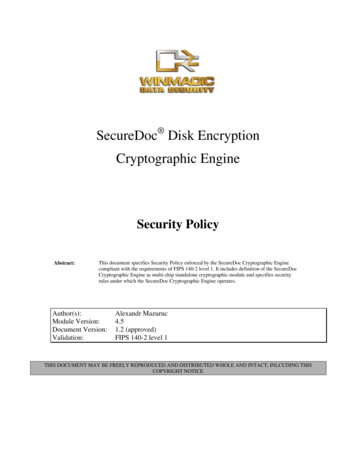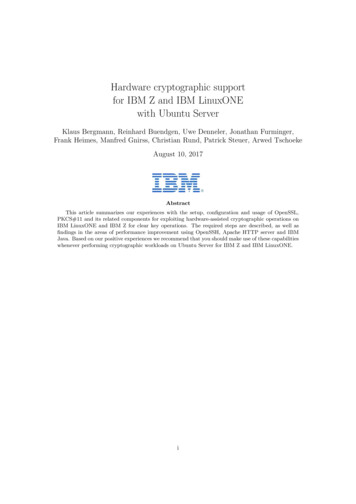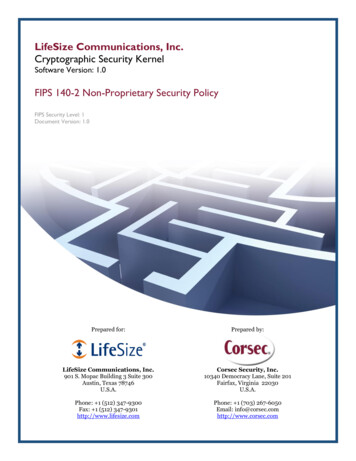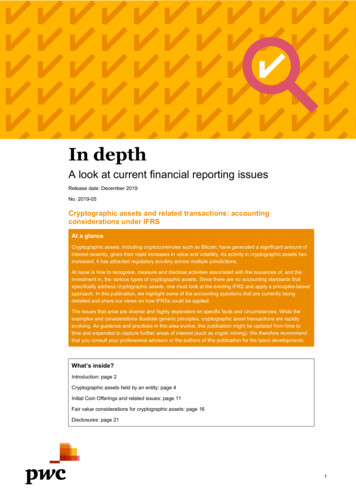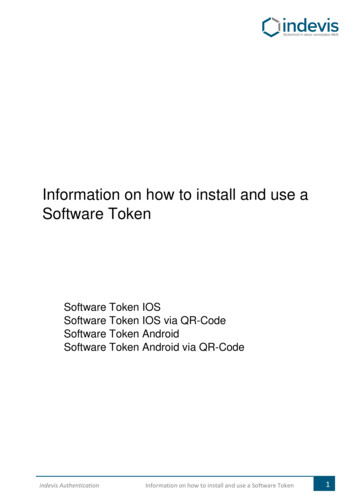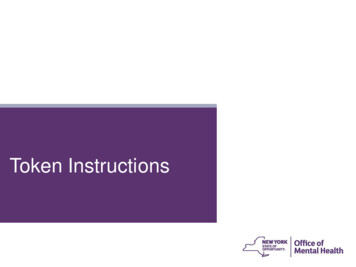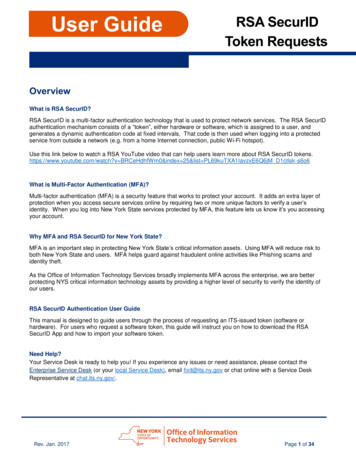
Transcription
Numeraire: A Cryptographic Token for Coordinating MachineIntelligence and Preventing OverfittingRichard Craib, Geo rey Bradway, Xander Dunnwith Joey Krughttps://numer.aiFebruary 20, 2017AbstractMachine learning competitions are susceptible to intentional overfitting. Numeraiproposes Numeraire, a new cryptographic token that can be used in a novel auctionmechanism to make overfitting economically irrational. The auction mechanismleads to equilibrium bidding behavior that reveals rational data scientists’ confidence in their models’ ability to perform well on new data. The auction mechanismalso yields natural arguments for the economic value of a Numeraire token.1MotivationA common approach to verify accuracy in machine learning is to break the dataset into train and test sets.A trained model can be tested for accuracy on the test set, which it has never seen. However, to maintainstatistical validity, this test set should only be used once. When a data scientist accesses the test set multipletimes and uses that score as feedback for model selection, there’s a risk of training a model that overfits thetest set. This hurts the model’s ability to perform well on new data.Figure 1:An overfitting curvewhere the test error continues todecrease with more submissionsfrom data scientists, but the erroron new data increases. [2]This overfitting problem is called adaptive data analysis [3]. Models resulting from adaptive data analysis1
range from slightly degraded to completely useless [4]. For Numerai, adaptive data analysis occurs whendata scientists’ models have overfit historical data, at the cost of live performance. In a machine learningcompetition there is incentive to overfit to the historical data because performance on that data dictateswinnings. Overfitting becomes intentional. What Numerai really needs is not a collection of great backteststhat work well on historical data, but a collection of great models that work well on new data.Currently, the state of the art solution to holdout reuse is to limit the amount of information exposedwhen using the holdout set [1]. While sufficent for scientific discovery, this solution heavily degrades userexperience and rankings in machine learning tournaments.We propose a new system for data scientists to communicate their beliefs about the quality of their models.Data scientists will compete in the new tournament by staking a new crypto-token, Numeraire (NMR), ontheir predictions. The auction mechanism for resolving these stakes will reward correct predictions of amodel’s ability to perform well on new data. With Numeraire, data scientists will now be able to expresstheir confidence in their models’ live performance. Their expressions of confidence help us to emphasize theright models and improve the performance of our hedge fund.2Cryptographic TokensNumeraire is an ERC20 Ethereum token [6]. Ethereum tokens are represented as smart contracts that areexecuted on the Ethereum blockchain. The source code to Numeraire’s smart contract is publicly available1 .All minted Numeraire are sent to Numerai. The Ethereum smart contract dictates there will never bemore than 21 million Numeraire minted. Numerai will send 1 million Numeraire to data scientists based ontheir historical ranking on Numerai’s leaderboard. After the initial distribution, the smart contract will minta fixed number of Numeraire each week until the maximum is reached. By performing well in Numerai’smachine learning competition, data scientists will earn Numeraire on an ongoing basis.When data scientists are confident of the predictions they have made, they send Numeraire to theNumeraire Ethereum smart contract. The receiving contract will hold the data scientists’ Numeraire for someholding period t, with t sufficiently large to judge performance on new data. After t has passed, Numerai willsend a message to the contract with information on which data scientists’ predictions performed well on newdata. Those data scientists whose predictions performed well earn dollars based on the auction mechanism,and their Numeraire are returned. Those data scientists whose predictions did not perform well on newdata risk having their Numeraire destroyed. The irreversible destruction of these Numeraire will be publiclyverifiable on the Ethereum blockchain.1 https://github.com/numerai/contract2
3Auction3.1OverviewEvery tournament has a staking prize pool, which is some fixed number of dollars. The auction mechanismallocates the prize pool among data scientists. Data scientists can submit bids to the auction. Bids aretuples (c, s) where c is confidence defined as the number of Numeraire the data scientist is willing to stake towin 1 dollar, and s is the amount of Numeraire being staked. For some time t, s is locked in the Ethereumcontract, inaccessible to anyone, including Numerai. After t has passed, a variant on the multiunit Dutchauction is used to determine the payouts.3.2Auction MechanismThe auction mechanism is a multiunit Dutch auction with some additional rules. Performance is evaluatedafter time t. The performance evaluation metric is logloss2 , a suitable metric for binary classification problemslike Numerai’s machine learning competition. A model is considered to have performed well if logloss ln(0.5), and badly if loglossln(0.5). The data scientists are ranked in descending order of confidencec. In descending order of confidence until the prize pool is depleted, data scientists are awarded s/c dollarsif their models performed well or they lose stake s if they perform badly. Once the prize pool is depleted,data scientists no longer earn dollars or lose their stakes.3.3ExampleAssume a prize pool of 3000 dollars, and that time t has elapsed. Assume the staking auction ended asfollows:Confidence cStake HIL CULLITON150005000NODAENRIS0.5300600YESABRIOSIWSW didn’t achieve logloss Logloss ln(0.5)Data Scientistln(0.5), so his 10,000 Numeraire are destroyed. XIRAX receives 500 andhis Numeraire are returned. PHIL CULLITON receives 2000 and his Numeraire are returned. DAENRIS’Numeraire are destroyed. ABRIOSI receives 500, 100 less than his bid because the prize pool is exhausted.Everyone below ABRIOSI will have the Numeraire returned and receive zero dollars.2 https://www.kaggle.com/wiki/LogarithmicLoss3
4Analysis of StakingLet p be the probability that the model achieves logloss ln(0.5) on new, unseen data. A low p wouldimply a high probability that a model is overfit. Let s be a data scientist’s total Numeraire staked. Let e bethe exchange rate of Numeraire per dollar. c is the confidence. A data scientist will stake Numeraire if theexpected value of staking Numeraire is positive. If a data scientist stakes s and achieves loglossln(0.5),sthe data scientist loses e dollars. If a data scientist stakes s and achieves logloss ln(0.5), the datasscientist wins c dollars. Therefore, the expected value in dollars of staking s with confidence c isE(c, s) psc(1p)seA data scientist will stake ifE(c, s)psc(10p)se0This impliespcc eThis results in self-revelation: Data scientists are moved to reveal their true inner values. Solely in theinterest of maximizing winnings, data scientists reveal their knowledge of their models’ abilities to generalizeto new, unseen data. As we let these tournaments repeat, we expect to see bidding behaviors that accuratelyreflect p, since overbidding and underbidding are both nonoptimal behaviors and the accuracy of estimatingp increases with time.Since having a higher confidence produces greater incentive to participate in an auction, we can makethe following observations: The higher p, the higher c a data scientist will submit, and the more dollars the datascientist can win from the auction. For a fixed p, a confidence that is too high produces E(c, s) 0, which will deter thisstrategy. Models that perform well on historical data but fail to generalize (low p) will eitherhave logloss ln(0.5) or have E(c, s) 0. Because Numeraire can be used by data scientists to earn dollars, the exchange ratee 0. Numeraire is worth more to data scientists with large p because they can use it to earndollars with higher confidence. A data scientist with p 1 has an expected value in dollars E(c, s) sc . To this datascientist, the value of all Numeraire is the net present value of all future stake payoutsby Numerai.4
The purpose of this auction is to get accurate probability estimates, not to maximize Numeraire staked.The auction need not be revenue maximizing, but self-revelation is important. While a weakly dominantstrategy in second priced auctions is to bid truthfully, second priced auctions are more susceptible to collusionand first priced auctions are more robust to this [5]. For this reason, and for simplicity, we use a Dutchauction (first priced) rather than an Ausubel auction.References[1] Dwork, Feldman, Hardt, Pitassi, Reingold, Roth. Generalization in Adaptive Data Analysis and HoldoutReuse. -adaptive-data-analysis-and-holdout-reuse.pdf.[2] Gringer. Distributed under a CC BY 3.0 License. n.[3] Hardt. Adaptive data analysis. ysis.html.[4] Hardt. Competing in a data science contest without reading the tml.[5] Krishna. Auction Theory. Elsevier, Massachusetts, 2010.[6] Wood. Ethereum: A Secure Decentralized Generalised Transaction Ledger.http://gavwood.com/paper.pdf.5
A common approach to verify accuracy in machine learning is to break the dataset into train and test sets. A trained model can be tested for accuracy on the test set, which it has never seen. However, to maintain statistical validity, this test set should only be used once. When a
